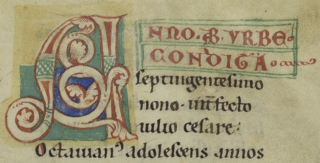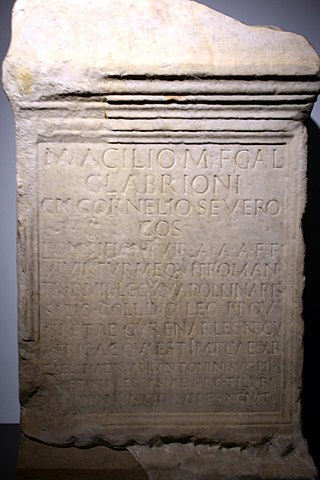Related Research Articles

Ab urbe condita, or anno urbis conditae, abbreviated as AUC or AVC, expresses a date in years since 753 BC, the traditional founding of Rome. It is an expression used in antiquity and by classical historians to refer to a given year in Ancient Rome. In reference to the traditional year of the foundation of Rome, the year 1 BC would be written AUC 753, whereas AD 1 would be AUC 754. The foundation of the Roman Empire in 27 BC would be AUC 727. The current year AD 2025 would be AUC 2778.

The 90s was a decade that ran from January 1, AD 90, to December 31, AD 99.

The 120s was a decade that ran from January 1, AD 120, to December 31, AD 129.
AD 96 (XCVI) was a leap year starting on Friday of the Julian calendar. At the time, it was known as the Year of the Consulship of Valens and Vetus. The denomination AD 96 for this year has been used since the early medieval period, when the Anno Domini calendar era became the prevalent method in Europe for naming years.
AD 53 (LIII) was a common year starting on Monday of the Julian calendar. At the time, it was known as the Year of the Consulship of Silanus and Antonius. The denomination AD 53 for this year has been used since the early medieval period, when the Anno Domini calendar era became the prevalent method in Europe for naming years.
AD 95 (XCV) was a common year starting on Thursday of the Julian calendar, the 95th Year of the Anno Domini (AD) designation, the 95th year of the 1st millennium, the 95th year of the end of the 1st century, and the 5th year of the 10th decade. In the Roman Empire, it was known as the Year of the Consulship of Augustus and Clemens. The denomination AD 95 for this year has been used since the early medieval period, when the Anno Domini calendar era became the prevalent method in Europe for naming years.
AD 98 (XCVIII) was a common year starting on Monday of the Julian calendar. At the time, it was known as the Year of the Consulship of Augustus and Traianus. The denomination AD 98 for this year has been used since the early medieval period, when the Anno Domini calendar era became the prevalent method in Europe for naming years.

100 (C) was a leap year starting on Wednesday of the Julian calendar, the 100th year of the Common Era (CE) and Anno Domini (AD) designations, the 100th year of the 1st millennium, the 100th and last year of the 1st century, and the 1st year of the 100s decade. As of the start of 100, the Gregorian calendar was 2 days behind the Julian calendar, which was the dominant calendar of the time.
Year 101 (CI) was a common year starting on Friday of the Julian calendar. At the time, it was known as the Year of the Consulship of Traianus and Paetus. The denomination 101 for this year has been used since the early medieval period, when the Anno Domini calendar era became the prevalent method in Europe for naming years.
103 (CIII) was a common year starting on Sunday of the Julian calendar. At the time, it was known as the Year of the Consulship of Traianus and Maximus. The denomination 103 for this year has been used since the early medieval period, when the Anno Domini calendar era became the prevalent method in Europe for naming years.
Year 124 (CXXIV) was a leap year starting on Friday of the Julian calendar. At the time, it was known as the Year of the Consulship of Glabrio and Flaccus. The denomination 124 for this year has been used since the early medieval period, when the Anno Domini calendar era became the prevalent method in Europe for naming years.

Year 251 (CCLI) was a common year starting on Wednesday of the Julian calendar. At the time, in the Roman Empire, it was known as the Year of the Consulship of Traianus and Etruscus. The denomination 251 for this year has been used since the early medieval period, when the Anno Domini calendar era became the prevalent method in Europe for naming years.
Year 186 (CLXXXVI) was a common year starting on Saturday of the Julian calendar. At the time, it was known as the Year of the Consulship of Aurelius and Glabrio. The denomination 186 for this year has been used since the early medieval period, when the Anno Domini calendar era became the prevalent method in Europe for naming years.
Year 67 BC was a year of the pre-Julian Roman calendar. At the time it was known as the Year of the Consulship of Piso and Glabrio. The denomination 67 BC for this year has been used since the early medieval period, when the Anno Domini calendar era became the prevalent method in Europe for naming years.
The gens Acilia was a plebeian family at ancient Rome, that flourished from the middle of the third century BC until at least the fifth century AD, a period of seven hundred years. The first of the gens to achieve prominence was Gaius Acilius, who was quaestor in 203 and tribune of the plebs in 197 BC.

Manius Acilius Glabrio was a plebeian Roman politician and general during the Republican. He served as consul in 191 BC while Rome was at war with the Seleucid Empire. He defeated Emperor Antiochus the Great at Thermopylae, helping establish Roman unipolar control over the Mediterranean, and was awarded a triumph. Credible accusations that he had embezzled spoils from his conquests in Greece while consul caused him to withdraw from his attempt to run for censor, after which he largely retired from public life.

Marcus Ulpius Traianus was a Roman general and senator. He was the biological father of emperor Trajan.
The lex Irnitana consists of fragments of Roman municipal laws dated to AD 91 which had been inscribed on a collection of six bronze tablets found in 1981 near El Saucejo, Spain. Together with the Lex Salpensana and the Lex Malacitana it provides the most complete version of the lex Flavia municipalis, or the Flavian municipal law. and has allowed new insights into the workings of Roman law. The tablets are exhibited in the Archeological Museum of Seville. Since the tablets provide the only surviving copy of large parts of the Flavian municipal law, they have provided new insights into the procedural side of municipal courts.

Manius Acilius Glabrio Gnaeus Cornelius Severus was a senator of the Roman Empire. He was consul ordinarius in 152 with Marcus Valerius Homullus as his colleague. Acilius Glabrio is known almost solely from surviving inscriptions.

Decimus Terentius Scaurianus was a Roman senator and general active in the late 1st and early 2nd centuries AD. He was suffect consul in either the year 102 or 104. He worked his way up through increasingly responsible positions. He commanded a legion from 96 to 98 and again during the Second Dacian War. After the war he was military governor of the newly conquered province from 106 to 111. He is known to have been decorated for his military service.
References
- ↑ Twitchett, Denis (2008). The Cambridge history of China. Vol. 1, The Ch'in and Han Empires, 221 B.C.-A.D. 220. Cambridge University Press. p. 421. ISBN 9781139054737.
- ↑ Suetonius (October 9, 2008). Lives of the Caesars. OUP Oxford. p. 378. ISBN 978-0-19-160910-7.